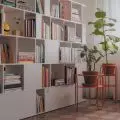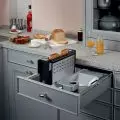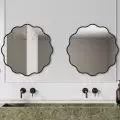The building designed by CO Architekci combines inspirations from German and Japanese architecture.
The house is 380 square meters
Photo by Dominika Stolar
Meeting of two cultures
The 380-square-meter house reflects the expressive, rich personality of its owner. Dawid Piątkowski is a tennis player, car enthusiast and traveler, as well as a businessman and author of many books. He is also a mentor.
- We poured a lot of the investor's personality traits into the project. We also decided to combine two cultures here, German and Japanese. Although distant from each other, they have a common denominator in the form of functionality combined with minimalism of form — says Piotr Lipski, owner of the studio.
The house includes a lot of glazing
Photo by Dominika Stolar
From German architecture, designers took the use of glass, concrete and stone. From the Japanese — lightness. Hence, among other things, the flattened lines of the sloping roofs, as well as the softly carved ceiling slab, passing smoothly into the canopy of the lower terraces.
- This plane cuts through the house at mid-height like a samurai's sword - he adds.
Designers used a lot of glass, concrete and stone
Photo by Dominika Stolar
Light diffused by tree leaves
The investor wanted open space, plenty of light and contact with nature. The building was shaped to preserve the trees growing on the plot. In addition, the architects used glazed walls, both inside and outside. As a result, the surrounding greenery becomes an integral part of the interior design. With newly planted trees in mind, striking holes were created in the ceiling slab. The sun filtered through the leaves penetrates to the inside. The Japanese call this komorebi. This solution is inspired by the designs of Tadao Andō, a legend of Japanese architecture.
The holes in the ceiling slab are inspired by the designs of Japanese architect Tadao Andō
Photo by Dominika Stolar
Materials inspired by the past
Two distinctive materials play a special role here: raw concrete and quartz sinter. Both from the facade permeate the interiors.
- We had the opportunity to design both the building and the interiors. So we were able to choose the leading materials in both the exterior and interior parts of the villa. The choice was between raw cast concrete and quartz sinter panels with a rust finish. They allude to the industrial past of Ruda Śląska — notes Piotr Lipski.
The rusty quartz sinter was used for example on the kitchen furniture fronts and facade
Photo by Dominika Stolar
Walls of reinforced concrete stood on two sides of the house. One is located in the entrance, the other at the end of the terrace. They were structurally connected to the terrace canopy. A crude cast of reinforced concrete in the form of an unplastered ceiling can also be seen in the interiors, more specifically in the living room, home office and garages. The second leading material is quartz sinter. Large-format slabs can be found on the facade and furniture fronts in the kitchen and home office.
Reinforced concrete walls stood on two sides of the house
Photo by Dominika Stolar
The wow effect
The house is L-shaped. From the street level it resembles a complex of two "modern barn" type buildings. The space connecting them houses the entrance area. However, the interior is completely integrated. On the lower level there is a home office and a living area with a kitchen open to the dining room, which further seamlessly connects to the living room.
- It's phenomenal to live here, mainly because of the wow effects I asked for when we talked about the project. We managed to get a lot of them per square meter in this house — says Dawid Piątkowski.
The glazed garages are particularly impressive. In the smaller one, adjacent to the home office, stand motorcycles. The investor can admire them while sitting behind the desk. The larger one houses sports cars, a Ducati and a Porsche. The upper level consists of a private area, with bedrooms as well as an exercise and yoga room. Clearances were also created here. Thanks to them, from the mezzanine in the bedroom we have a view of the living area while from the fitness room we can admire the garden, which is a continuation of the first floor.
- I very often let guests into the house through the garage. There is a Ducati, a Porsche, there are also brilliantly lit paintings — it all works together in an amazing way. And that space we talked about, to make it as big as possible.... Indeed there is, and it makes an electrifying impression! — describes the investor.
In the glass garages motorcycles and sports cars were exposed
Photo by Dominika Stolar
Are you decorating your apartment? We have more inspiration for you!
Compiled by:KATARZYNA SZOSTAK












































